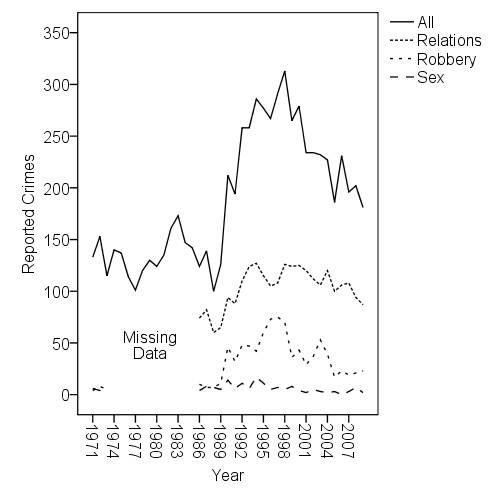ABSTRACT
During the communistic control of Czechoslovakia sexually explicit materials (SEM) of all sorts were strictly prohibited. Following the 1989 social revolution and turn to democracy all sorts of pornography and sexually explicit materials became readily available. This study compares the periods before and after the regime shift in regard to changes in sex crimes reported as possibly related to the relatively new exposure to SEM.
In particular we focused on the incidence of reported cases of rape and child sex abuse since these crimes are generally considered among the most significantly related to pornography. As comparative measures we investigated the incidence of murders, robbery and assaults associated with sex-related motives and those without such motives.
Basic findings were that the reported number of child sex abuse cases decreased significantly following the advent of legally and readily available SEM while the number of rapes reported remained about the same. Lesser sex related crimes (e.g. indecent exposure) also decreased significantly. In comparison, measures of non-sex related murders and other social crimes and cases of non sex-related violence increased significantly while those crimes potentially associated with sex did not.
The ready availability of SEM over an extended period of time in the Czech Republic, as found everywhere else studied, was not correlated with any significant increase in sex related crime. Significantly, readily available SEM was associated with a decrease in child sex abuse even while the possession of child pornography was not illegal.
METHODS
Subjects
Czechoslovakia (Československo) had been a sovereign federated government formed in 1918 and consisting of two separate states. On 1 January 1993 the federation peacefully again split into the Czech Republic and Slovakia. For the present study only the pre and post separation population and crime data pertinent to the Czech Republic are used.
Time Intervals
The time ranges used for this study started in the mid 1970s, a fifteen-year period when even items like Playboy magazine, were banned. With the coming of democracy in 1989, the laws regarding dissemination and availability of pornography were considerably loosened. Even child pornography was not illegal. This period covers eighteen years of major socio-political changes. Our study period ends with data from 2007.
RESULTS
Child Sex Abuse
Most obvious and most significant is that the number of reported cases of child sex abuse immediately dropped markedly after SEM was legalized and became available (t = 6.7, df = 32, p <.001) (Figure 1).
The incidence of reported child sex abuse, did increase in incidence for a few years to peak in 1995 and 1998 but again dropped in number following a downward trend that began prior to democratization (Figure 1).
Statistical analysis using Pearson's r for the relation between the number of males aged 15-64 in the population and cases of child sex abuse found a negative correlation (Pearson's r = -.787; p = .001).
Rape
Reported cases of rape did briefly pitch upward following the change to democracy and the availability of pornography but then returned to its frequency seen during the period under communism; between about 500 to 750 cases a year (Figure 1). This stability maintained despite a significant increase in male population.
Paraphilias
The so-called lesser sexual offences of exhibitionism, peeping, etc. also decreased significantly following the legal availability of SEM (t = 9.57, df = 20, p = .001) (Figure 1).
Non-sex Crimes
In comparison with our findings for the sex crimes mentioned following democratization and porn availability, the number of societal crimes of general murder, assault and robbery rose significantly.
Murders associated with robbery or with other non-sex related motives increased sharply (t = -6.8, df = 20, p < .001) .Murders associated with sex related matters—small in number at any time—did not increase (t = -0.3, df = 23, p = -.77).
The number of reported sex related crimes decreased significantly from the pre-switch period to the post period (t = 5.3, df = 32, p < .001), whereas the number of reported nonsexual crimes increased significantly (t = -19.72, df = 35, p < .001) (Figure 3).
DISCUSSION
The most obvious and significant finding is that since 1989 with the shift from a political system with its total ban on SEM and anything that might be considered pornographic to the present regime and the widespread availability of SEM in various media and the Internet, is that the incidence of reported sex related crimes has not increased.
Most critically, child sex abuse, despite a brief upswing toward its predemocracy rate, resumed a decline while even child porn was not illegal.
The number of reported rapes and attempted rapes, after an immediate but brief rise following the release from communism and advent of available SEM, returned to their pre-revolution numbers. This occurred despite a significant increase in the male (and female) populations).
The lesser sex related crimes of peeping and exhibiting also dropped significantly and appear to have reached a low and steady state.
Meanwhile other social crimes such as murder, assault and robbery increased significantly (Figure 3).
CONCLUSIONS
It is mythology that pornography of any type in the Czech Republic is associated with any increase in rape, child sex abuse or paraphilias such as exhibitionism or peeping. Despite large increases in all sorts of SEM since the change from a communistic government to one of democracy no increase in sex related crime has been documented.
It is suggested that masturbation or other legitimate outlet associated with the available porn has provided a readily available substitute for sexual crimes without any associated risk.
========
Figure 1: Number of reported rapes, cases of Child Sex Abuse and Lesser Sex Crimes (e.g. indecent expos) reported 1971-2007. Data on Lesser Sex Crimes were not recorded before 1986. Child sex abuse data for the years 1971-1973 were not available.

Figure 2: Number of convicted rapists and convicted child sex abuse offenders in 1979-2007

Figure 3: The number of convictions for those accused of sexual and nonsexual crimes during the years 1971 to 2007.

